Korzok Monastery
Korzok, is a Tibetan Buddhist monastery belonging to the Drukpa Lineage. It is located in the Korzok village, on the northwestern bank of Tso Moriri (lake) in Leh District, Ladakh, India. The gompa (monastery), at 4,560 metres (14,960 ft), houses a Shakyamuni Buddha and other statues. It is home to about 70 monks.[1]
| Korzok Monastery | |
|---|---|
 Korzok Gompa | |
| Religion | |
| Affiliation | Tibetan Buddhism |
| Festivals | Korzok Gu-stor |
| Location | |
| Location | Korzok, on the western bank of Tsomoriri Lake in Leh District, Ladakh |
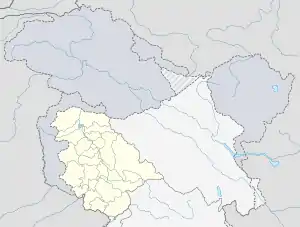 Location within India | |
| Geographic coordinates | 32.965758°N 78.253374°E |
| Architecture | |
| Style | Tibetan Architecture |
In the past, the monastery was the headquarters of the Rupshu Valley. It is an independent monastery under Korzok Rinpoche, widely known as Langna Rinpoche. The 3rd Korzok Rinpoche, Kunga Lodro Ningpo was the founder of Korzok Monastery.
The revered monastery is 300 years old. The Tso Moriri Lake below it is also held in reverence, and considered equally sacred by the local people. With the efforts of the WWF-India the Tsomoriri has been pledged as a 'Sacred Gift for a Living Planet' by the local community (mostly Chang-pa herdsmen). As a result, the area has been opened up for tourists.[2]
Etymology
The word ‘Korzok’ is a derivative of two words, namely ‘Kor’ meaning a place in the Ladakhi language and ‘Zok’ which is said to be a derivative of the word ‘dzot-pa’ meaning "manager". Over the years, the last letter of the word was changed to ‘k’ to the derivative word Zok and together with Kor came to be known as "Korzok". Another explanation attributed is that shepherds working for the monasteries in the nearby hamlets kept the king’s cattle at this place, not only to tend them but to also extract milk, cheese and butter. Hence, the place came to be known as "Korzok".[3]
It is said that the nomads were exploited by the Monastery as they were paid very meagre amounts for the services rendered. Hence the place was given the name 'Korzok' (meaning: acquired by unfair means).[3]
History
The history of Korzok is traced back to kings who ruled in the inhospitable terrain and fought several wars. They suffered several setbacks in wars and had to lead a nomadic life in isolation. One of the kings of this nomadic lineage had sent his emissary to Tibet seeking help. He brought a Lama from Tibet who established the monastery at Korzok about 300 years ago. Since then the nomads preferred to change their animistic religion and adopt to Buddhism. They preferred living peacefully and in harmony with their surroundings and animals. The reign of the nomadic kingdom ended with their last King Tsewang Yurgyal, who ruled until August 1947 when India became a democratic country.[4]
Korzok was in the Central Asian trade route till 1947 and was the headquarters of Rupshu Valley. One of the kings, Rupshu Goba, who lived there with his family, built nine permanent houses there.[3]
The village has several houses, but the floating population of the nomads, establishing their tents (made of yak hair or skin) in summer, adds to the agricultural operations in the region.[4] The tents are provided with vents at the top to let out smoke. Pashmina (yak’s wool) is the valuable product that the Changmas trade along with the salt that they extract from large salt fields in the area, such as the springs at Puga. They barter these two products for food grains and other necessities. In Korzok, in recent years, building activity is on the rise with the nomadic tribes changing their life style.[5]
Structures
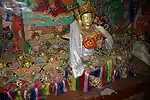 |
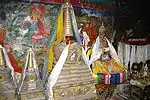 |
| Shakyamuni Buddha and other statues | Chortens and a Buddha statue |

Korzok monastery as seen now is said to have been re-built in the 19th century on the right bank of the Tsomoriri River. The old monastery was built on a gentle slope, unlike other monasteries that are generally perched on hill tops. An impressive photong is also located near to the Gompa. A number of Chortens are also seen near the monastery.[6][7][8] Korzok settlement is considered as one of the oldest settlements of the world at this altitude. [9]
The monastery houses the statue of Shakyamuni Buddha along with images of other deities.[10] The monastery has beautiful paintings (Thangkas); old paintings which have been restored.[11]
Geography

Korzok Monastery is situated on the northwestern bank of Ladakh's Tso Moriri (lake), one of the highest lakes in the world of its size. The lake covers an area of 120 square kilometres (46 sq mi).[12] The water of the lake is partly brackish and partly sweet. Its depth in the lake is 30 metres (98 ft). The valley formed by the Tso Moriri and other lakes, is known as part of the Rupshu Valley and Plateau. The lake and its surrounding area is a Ramsar designated wetland.[2]
Korzok is on the Ladakhi portion of the Changthang plateau amidst snow peaks that are the source of water to the lake. The Rupshu -Changthang area is a unique landscape. The barley fields in the Korzok village vicinity tended by the nomadic Chang-pa herdsmen (apart from the monks staying in the monastery) have been claimed to be the highest cultivated land in the world.[1] The nomadic herdsmen seen here living in tents only, rear herds of goats, cows and yaks. The wildlife seen in the area consists of Himalayan birds, wild ass (Kiang), foxes and marmots.[1][2][6][13] The streams, which rise in the valley, are used for irrigation. Summer temperatures in the area reach a high of 36 °C (97 °F) and a low of 5 °C (41 °F).[3]
Local festival

The Korzok Gu-stor festival is held at the monastery and attracts many Chang-pa, the Tibetan plateau nomadic herdsmen.[14] At the festival masks are worn by the dancers to represent the Dharmapalas (guardian divinities of the Buddhist pantheon), and the patron divinities of the Drukpa sect of Tibetan Buddhism.[14] The annual monastic festival is also held not only at Korzok but also at the Thuje in the Chungthan valley where the nomadic tribes fervently participate in the rituals. They not only make donations to the monasteries but also dedicate one son from each family to the monastery. It is said that the local nomads are so dedicated to Buddhism that opposite to their tents they allocate space to keep symbolic statue images of the Rinpoche, usually the Dalai Lama, along with the seven offering cups, in perfect harmony with their own folk (nomadic) religious deities and spirits.[15]
Visitor information
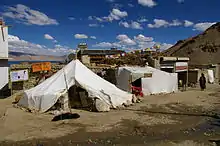
The monastery is located to the southeast of Leh in eastern Ladakh, at a road distance of 215 kilometres (134 mi) from Leh. It is also approachable from Manali. Leh is also connected by air with many destinations in India.
A permit (obtainable at Leh only) is essential for entry into the area. Only tented accommodation, pitched on the banks of the Tso Moriri, is available for visitors.[6]
Gallery
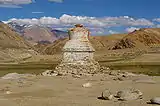 A Chorten in Kurzok
A Chorten in Kurzok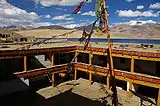 View of the Korzok Monastery
View of the Korzok Monastery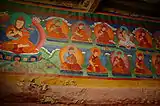 Painting in the Korzok Monastery
Painting in the Korzok Monastery Paintings in the Korzok Monastery
Paintings in the Korzok Monastery
References
- "India's eleven new Ramsar sites". Retrieved 21 November 2009.
- "Tsomoriri". WWF India. Archived from the original on 2 March 2009. Retrieved 21 November 2009.
- Jina, Prem Singh (1995). High pasturelands of Ladakh Himalaya. Korzok. Indus Publishing. p. 49. ISBN 978-81-7387-026-2. Retrieved 22 November 2009.
- Kohli, Harish (2000). Across the frozen Himalaya: the epic winter ski traverse from Karakoram to ... Korzok. Indus Publishing. p. 109. ISBN 978-81-7387-106-1. Retrieved 22 November 2009.
- "Tso Moriri - Tea with Changpas". The Statesman. 16 June 2004. Retrieved 23 November 2009.
- Bindloss, Joe; Sarina Singh (2007). India. Korzok. Lonely Planet. p. 386. ISBN 978-1-74104-308-2. Retrieved 22 November 2009.
Korzok.
- "Tso Moriri in Ladakh: A sacred gift for a living planet". Retrieved 23 November 2009.
- Outlook Traveller Magazine. Korzok. Outlook Publishing. July 2008. p. 82.
- "Volunteer Tso Moriri". Archived from the original on 28 August 2008. Retrieved 23 November 2009.
- "Chang Thang". Retrieved 22 November 2009.
- Outlook p.59
- Outlook Traveller Magazine. Outlook Publishing. July 2008. p. 87.
- "Ladakh Sightseeing and Places of interest". Archived from the original on 1 July 2012. Retrieved 21 November 2009.
- "Korzok Gustor Festival". Footloose India. 2007. Retrieved 1 September 2008.
- Rosing, Ina; Sonam Norboo Spurkhapa (2006). Shamanic trance and amnesia: with the shamans of the Changpa nomads in ... Korzok Monastery. Concept Publishing Company. pp. 89–92. ISBN 978-81-8069-247-5. Retrieved 21 November 2009.